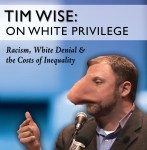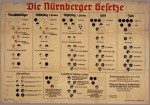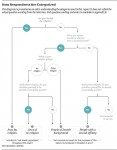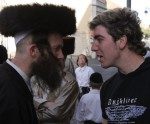 Concluding a review of glaring differences between Whites and jews.
Concluding a review of glaring differences between Whites and jews.
Two Lessons in Privilege from April 2013.
Susan Patton advised Princeton women:
For most of you, the cornerstone of your future and happiness will be inextricably linked to the man you marry, and you will never again have this concentration of men who are worthy of you.
Here’s what nobody is telling you: Find a husband on campus before you graduate. Yes, I went there.
Under the initial presumption that Patton was a “WASP”, she was condemned as an elitist and “racist”. Once she played the jewish mother card all the anger and criticism turned into understanding and sympathy.
Suzy Lee Weiss wrote an op-ed for the Wall Street Journal complaining about being rejected by elite colleges:
For starters, had I known two years ago what I know now, I would have gladly worn a headdress to school. Show me to any closet, and I would’ve happily come out of it. “Diversity!” I offer about as much diversity as a saltine cracker. If it were up to me, I would’ve been any of the diversities: Navajo, Pacific Islander, anything. Sen. Elizabeth Warren, I salute you and your 1/32 Cherokee heritage.
This too resulted in condemnation, until Tablet Magazine called her “family”, and Commentary Magazine (the mouthpiece of the American Jewish Committee) published two articles defending her. Then she started getting job offers.
An article in National Review Online played on the conflation of jews and Whites. To All the Colleges That Rejected Suzy Weiss:
Such sarcasm is seen as blasphemy in universities and colleges throughout America. Their faculty and administrative officers, and their professional associations, such as the American Council on Education, the American Association of State Colleges and Universities, and the American Association of University Professors, overwhelmingly believe — firmly and unapologetically — that out-and-out racial and ethnic discrimination in college admissions is fully acceptable in the interests of “diversity.” Discriminating against culturally “nondiverse” Caucasians such as Suzy Weiss is, in their eyes, the right thing to do. And they want the Supreme Court to recognize such discrimination as constitutional.
Perhaps we should not be surprised that Ivy League and other top-notch schools practice such ugly discrimination. After all, they had similar practices in the 1920s to ensure their schools did not have “too many” Jewish students. Today, they just want to make sure they don’t have “too many” Caucasians or Asians on campus. All they have done is change the groups targeted for discrimination.
Suzy Weiss and many other high-school seniors across the United States are being discriminated against because of their skin color or because they have an epicanthic fold in their eyes. Such racial and ethnic discrimination is morally wrong, and neither “diversity” nor anything else can justify it.
Ron Unz has tried to get out in front of the who/whom of American university admissions. In The Myth of American Meritocracy he writes:
For a broader historical perspective, we should consider The Chosen by Berkeley sociologist Jerome Karabel, an exhaustive and award-winning 2005 narrative history of the last century of admissions policy at Harvard, Yale, and Princeton (I will henceforth sometimes abbreviate these “top three” most elite schools as “HYP”).
Karabel’s massive documentation—over 700 pages and 3000 endnotes—establishes the remarkable fact that America’s uniquely complex and subjective system of academic admissions actually arose as a means of covert ethnic tribal warfare. During the 1920s, the established Northeastern Anglo-Saxon elites who then dominated the Ivy League wished to sharply curtail the rapidly growing numbers of Jewish students, but their initial attempts to impose simple numerical quotas provoked enormous controversy and faculty opposition.10 Therefore, the approach subsequently taken by Harvard President A. Lawrence Lowell and his peers was to transform the admissions process from a simple objective test of academic merit into a complex and holistic consideration of all aspects of each individual applicant; the resulting opacity permitted the admission or rejection of any given applicant, allowing the ethnicity of the student body to be shaped as desired.
The massively footnoted text of The Chosen might lead one to paraphrase Clausewitz and conclude that our elite college admissions policy often consists of ethnic warfare waged by other means, or even that it could be summarized as a simple Leninesque question of “Who, Whom?”
Asian-Americans as the “New Jews”
The overwhelming focus of Karabel’s book is on changes in Jewish undergraduate percentages at each university, and this is probably less due to his own ethnic heritage than because the data provides an extremely simple means of charting the ebb and flow of admissions policy: Jews were a high-performing group, whose numbers could only be restricted by major deviations from an objective meritocratic standard.
Obviously, anti-Jewish discrimination in admissions no longer exists at any of these institutions, but a roughly analogous situation may be found with a group whom Golden and others have sometimes labeled “The New Jews,” namely Asian-Americans.
“The new jews” has also been used in reference to muslims, especially in Europe. It is an implicit reference to the jewish narrative distinguishing jews and Whites – with jews oppressed and Whites as their oppressors.
Once we begin separating out the Jewish portion of Ivy League enrollment, our picture of the overall demographics of the student bodies is completely transformed. Indeed, Karabel opens the final chapter of his book by performing exactly this calculation and noting the extreme irony that the WASP demographic group which had once so completely dominated America’s elite universities and “virtually all the major institutions of American life” had by 2000 become “a small and beleaguered minority at Harvard,” being actually fewer in number than the Jews whose presence they had once sought to restrict.50 Very similar results seem to apply all across the Ivy League, with the disproportion often being even greater than the particular example emphasized by Karabel.
In fact, Harvard reported that 45.0 percent of its undergraduates in 2011 were white Americans, but since Jews were 25 percent of the student body, the enrollment of non-Jewish whites might have been as low as 20 percent, though the true figure was probably somewhat higher.51 The Jewish levels for Yale and Columbia were also around 25 percent, while white Gentiles were 22 percent at the former and just 15 percent at the latter. The remainder of the Ivy League followed this same general pattern.
This overrepresentation of Jews is really quite extraordinary, since the group currently constitutes just 2.1 percent of the general population and about 1.8 percent of college-age Americans.52 Thus, although Asian-American high school graduates each year outnumber their Jewish classmates nearly three-to-one, American Jews are far more numerous at Harvard and throughout the Ivy League. Both groups are highly urbanized, generally affluent, and geographically concentrated within a few states, so the “diversity” factors considered above would hardly seem to apply; yet Jews seem to fare much better at the admissions office.
Even more remarkable are the historical trajectories. As noted earlier, America’s Asian population has been growing rapidly over the last couple of decades, so the substantial decline in reported Ivy League Asian enrollment has actually constituted a huge drop relative to their fraction of the population. Meanwhile, the population of American Jews has been approximately constant in numbers, and aging along with the rest of the white population, leading to a sharp decline in the national proportion of college-age Jews, falling from 2.6 percent in 1972 and 2.2 percent in 1992 to just 1.8 percent in 2012. Nevertheless, total Jewish enrollment at elite universities has held constant or actually increased, indicating a large rise in relative Jewish admissions. In fact, if we aggregate the reported enrollment figures, we discover that 4 percent of all college-age American Jews are currently enrolled in the Ivy League, compared to just 1 percent of Asians and about 0.1 percent of whites of Christian background.53
Menachem Rosensaft: Israel’s Jewish Essence Is Non-Negotiable: A Response to Mahmoud Abbas, Huffington Post, 5 November 2011:
“My people,” Abbas declared, “desire to exercise their right to enjoy a normal life like the rest of humanity. They believe what the great poet Mahmoud Darwish said: Standing here, staying here, permanent here, eternal here, and we have one goal, one, one: to be.”
Our unambiguous response must be that we insist on precisely the same rights Darwish demands for the Palestinians. For us, a permanent, eternal Jewish sovereignty in the State of Israel is not only non-negotiable but must be, especially in the aftermath of the Holocaust, one of the cornerstones of any authentic and hopefully lasting peace.
When the remnant of European Jewry emerged from the death camps, forests and hiding places throughout Europe in the winter and spring of 1945, they looked for their families and, overwhelmingly, discovered that their fathers and mothers, their husbands, wives and children, their brothers and sisters, aunts, uncles, and cousins, had all been murdered by the Germans and their accomplices. And yet, they did not give in to despair.
On the contrary, almost from the moment of their liberation, the Holocaust survivors’ defiant affirmation of their Jewish national identity in the Displaced Persons camps of Germany, Austria, and Italy took the form of a political and spiritually redemptive Zionism.
My father, who taught me that a love of the Jewish people and of the State of Israel is the most important element of Jewish leadership, understood that the goal of a Jewish state was a spiritual lifeline that gave the survivors of Auschwitz, Treblinka, Belsen, and all the other centers of horror a sense of purpose and a basis for hope. He died 36 years ago this week during the Days of Awe, midway between Rosh Hashanah and Yom Kippur. I cannot think of a worthier way to honor his memory than by evoking his spirit and his uncompromising dedication to the creation of a new Jewish commonwealth to refute each and every refusal to recognize Israel as a Jewish state.
Menachem Rosensaft: White Nationalism: A Scourge That Won’t Go Away, Huffington Post, 12 March 2012:
Reacting to the inclusion of the “white nationalist” anti-immigration activist Peter Brimelow on a panel on “The Failure of Multiculturalism: How the Pursuit of Diversity Is Weakening the American Identity” at this year’s Conservative Political Action Conference (CPAC), Ed Schultz observed on MSNBC’s The Ed Show that, “We’ve come to expect CPAC to bring together the far righties. But even CPAC should draw the line somewhere.”
Schultz went on to quote Brimelow as having said at CPAC that, “Democrats have given up on winning the white working class vote, so they use bilingualism to build up a client constituency. It’s treason. We hear about racism, but the real issue is treason.”
Brimelow certainly doesn’t mince words. He told a CBS reporter that US immigration policy, the legal kind, mind you, “is creating a “Spanish speaking underclass parallel to the African American underclass.”
“These are people who are completely dysfunctional,” Brimelow said. “They’re on welfare; they’re not doing any kind of work — at least not legal work — and their children are having a terrible time.” California, which used to be “paradise,” he added, is “rapidly turning into Hispanic slum.”
Nice. So who, precisely, is Peter Brimelow, and why should the rest of us be concerned when a white nationalist racist like him appears at the same event as, say, Mitt Romney, Newt Gingrich, Rick Santorum and Sarah Palin?
Brimelow is founder and editor of the VDARE.com website which has been designated a “hate group” by the Southern Poverty Law Center, and which, according to no less an authority than the Anti-Defamation League, “features the work of racists, anti-Semites and anti-immigrant figures.”
The ADL has been following Brimelow’s activities for some time. In February of 2009, the organization tells us, “Brimelow demonstrated his racist views” at “a conference of racists in Baltimore, Maryland, dedicated to ‘Preserving Western Civilization.'” There, Brimelow “delivered one of the most extreme presentations at the conference. He argued that the influx of “non-traditional” immigration is a problem all over the Western world and that the loss of control over the country by “white Protestants” will mean a collapse of the American political system. He urged that whites respond by creating an explicitly white nationalist political party.”
Hmm? An “explicitly white nationalist political party”? Where have we heard that before?
We all know that there are bigots amongst us who espouse theories of racial, ethnic or religious superiority. They have the right to express their views, however noxious, on street corners or on their websites. No one, however, is obliged to invite them to be part of polite society.
The fact that the organizers of CPAC chose to give Peter Brimelow a platform reflects on them. Why the other CPAC participants have chosen not to denounce or even distance themselves from his toxic rhetoric is a question well worth asking.
Menachem Z. Rosensaft, Wikipedia:
Menachem Z. Rosensaft, (*1948 Bergen-Belsen, Germany) an attorney in New York and the Founding Chairman of the International Network of Children of Jewish Survivors, is a leader of the Second Generation movement of children of survivors,[1] and has been described on the front page of the New York Times as one of the most prominent of the survivors’ sons and daughters.[2] He also served as National President of the Labor Zionist Alliance, and was active in the early stages of the Israeli-Palestinian peace process. As psychologist Eva Fogelman has written: “Menachem Rosensaft’s moral voice has gone beyond the responsibility he felt as a child of survivors to remember and educate. He felt the need to promote peace and a tolerant State of Israel as well. He wanted to bring to justice Nazi war criminals, to fight racism and bigotry, and to work toward the continuity of the Jewish people”.[3]
In March 2009, Menachem Rosensaft was appointed as general counsel of the World Jewish Congress, the umbrella organization of Jewish communities around the world based in New York.[4] Currently, Menachem Rosensaft is Adjunct Professor of Law at Cornell University Law School,[5][6] and Distinguished Visiting Lecturer at Syracuse University College of Law.[7] In 2011 he was appointed lecturer in law at Columbia University Law School where he teaches a course in the law of genocide.[8]
Israel Can Never Be Too Jewish, by Yaakov Dov Bleich, Forward.com, 9 September 2013:
Interesting to ask, has there ever been a debate in France about “French identity, too much or too little”? Or in Germany? Holland? England? The United States? Our Jewish identity, based on our Jewish traditions, is what has given us the connection to this Holy Land for so many thousands of years. It is what has kept us together, and it is what joins us today. It is our distinguishing character. It was in Egypt before we became a nation, and it is today. There can never be too much Judaism. Our Jewish Identity can never be too much. It can only be too little.
Is Israel too Jewish? An unorthodox solution, by Rick Jacobs, Haaretz, 11 September 2013:
My love for Israel is at the core of my Jewish identity, yet, as president of the largest movement of Jews in North America, the Reform movement, I find the religious status quo destructive to Jewish unity. Too many Diaspora Jews are disconnecting from an Israel that does not honor, reflect or support their core Jewish commitments.
Of course, Israel faces enormous external security threats, but it also faces an existential threat to its very soul and character. We need a global conversation about how to practice Judaism across borders, where Diaspora Jewry and Israeli Jewry can enrich each other.
But we must ensure that Israel represents a Jewish state that truly embodies the values and vibrancy of all Jewry, seeking to create a just and secure nation that will continue to link us as a people across oceans and across generations. Judaism and democracy can thrive only in an Israel with true freedom, freedom that embodies the dreams and promises of Israel’s Declaration of Independence: “to uphold the full social and political equality of all its citizens, without distinction of race, creed or sex… guarantee full freedom of conscience, worship, education and culture… be based on freedom, justice and peace….”
In the free marketplace of Diaspora Jewish life, Orthodoxy and liberal Judaism are both flourishing, so why be afraid of affirming the legitimacy of the many authentic Jewish paths, including, too, the secular/cultural? Young Jews worldwide are searching for answers — and how they define their Jewish identities should be a source of renewal for the Jewish state.
The difference between jews and Whites is the difference between a parasite and its host. Jews pathologize Whites, literally cause pathology. They are pathogenic.
The podcast will be broadcast and available for download on Tuesday at 9PM ET.
Podcast: Play in new window | Download


















